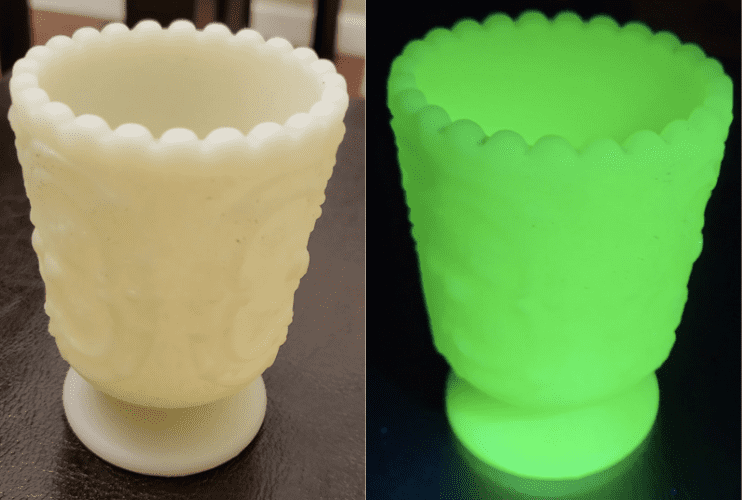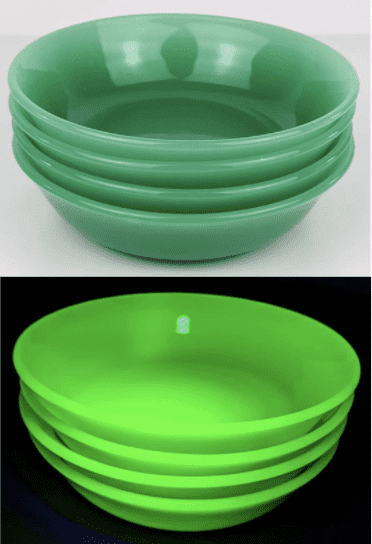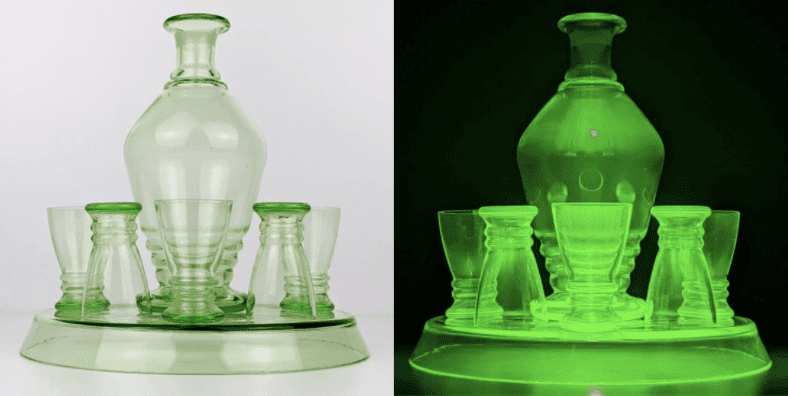When it comes to antiques, Uranium glass is something special. If you’ve got a piece, you can be sure of having something to talk about to impress your friend, but how do you identify it?
An ultraviolet (UV) blacklight can be used to confirm that glassware has Uranium in it. Shining a blacklight on Uranium glass will make it light up with a neon green glow, which shows that the glass contains Uranium. Glass will only glow in this way if it was made with Uranium.
From its chemical discovery to its notorious ban, Uranium glass has a rich history behind it. Keep reading to learn more about the ways to identify Uranium glass.

Who Made Uranium Glass
Glassblowers in Bohemia started off the commercial production of Uranium glass. The popularity of the “Bohemian glass” spread, and the Choisy-le-Roi factory in France caught on. From there, the methods continued to spread.
More recently, producers of Uranium glass have included Bagley’s of Yorkshire, Fenton Art Glass, Boyd Glass, Mosser Glass, Gibson Glass, and Jack Loranger.
Most, if not all, of these companies have since discontinued their production of Uranium glass.

Who Invented Uranium Glass
Martin Klaproth, the German chemist who recognized Uranium as a unique chemical element in 1789, is rumored to have been the one to first add it to glass. (Source)
However, other glassmakers didn’t start using Uranium in glass until 50 years later. Josef Riedel was the first to produce Uranium glass commercially, naming two of the colors made by adding Uranium (yellow and yellow-green) after his daughter, Anna Maria. Those colors of Uranium glass are called “annagelb” and “annagrün”, respectively. (Source)
Uranium was used to color glass for the competitive edge the new colors offered buyers in an aggressive market.
When Was Uranium Used in Glass
Josef Riedel pioneered blowing Uranium glass in Bohemia in 1830, kicking off the market. Uranium glass reached its peak in popularity in the period of time between the years 1880 through the 1920s.
Production came to a halt during the ban of 1943. It resumed in the late 1950s after the ban was lifted, but it had lost its momentum and much of its popularity, coming to a grinding halt by 2014.
There may still be glassblowers today who experiment with Uranium as a hobby, but commercial production has largely come to an end.

Did Fenton Make Uranium Glass
Yes, Fenton Art Glass used to make Uranium glass. If you go to their site today and try to search for it, though, you will be disappointed. The result of such a search yields a server error because they don’t have anything in the directory to match.
Fenton no longer makes or sells Uranium glass. They closed their museum and plant in 2013 and then started auctioning off the products that they had leftover. The last of these auctions was held in July 2014. (Source)
If you want to find Uranium glass today that was made by Fenton Art Glass, your best bet is to search for it on eBay or Etsy, though you might get lucky and find some at an antique store near you.

When Was Uranium Glass Banned
The production of Uranium glass was banned in the US in 1943. It was also banned in the UK. Both governments wanted to restrict access to Uranium for military reasons, as well as for concern for the health of the workers dealing with Uranium. The government confiscated all supplies of Uranium at that time. (Source)
The ban was lifted in November of 1958 and production resumed the next year. However, supplies of uranium dioxide were low, so production didn’t pick up much speed at that time.
Instead, Uranium was being used as a power source, which had a much higher demand than art glass pieces, especially with electricity picking up. This made the Uranium glass that was made at that time more scarce and expensive.
Is Uranium Glass Still Made
While you might chance upon an individual who still makes Uranium glass today, you won’t find it being produced en mass by any major manufacturers. Companies like Fenton Art Glass and Mosser Glass have stopped producing Uranium glass nearly a decade ago.
You can still find Uranium glass to buy on eBay and in some antique stores, but its production is largely discontinued.

On the other hand, formulas for making it are still floating around for glassmakers to come across. Some formulas are just available online, and there are even YouTube tutorials detailing how to make it.
When Did They Stop Making Uranium Glass
Glass manufacturers stopped making glass during the 15 year period when it was banned. They resumed after that, but they have since stopped once again. Of all the companies listed previously: Fenton Art Glass, Boyd Glass, etc, they have all stopped producing Uranium glass.
The most recent company to stop producing Uranium glass is Fenton Art Glass, which stopped producing in 2013.
Why Did They Stop Making Uranium Glass
Aside from the ban in 1943, which was put in place by the government for both military and safety concerns, the reasons glass companies have stopped making glass more recently involve problems that any business might run into.
For one thing, Uranium has been a lot more expensive since the regulations were dropped in 1958, making it a lot harder for glass companies to get a hold of. After all, they had to compete with power companies for access to Uranium, and electricity was a lot more popular than Uranium glass at the time.
Speaking of popularity, after the ban was lifted, Uranium glass wasn’t as sought-after as it had been in the early twentieth century, and anyone who knows anything about economics can tell you what that will do to a business.

That low supply combined with a low demand puts equilibrium so far out of the question that I’m frankly surprised these glassmakers didn’t stop sooner, but you’ve got to commend them for trying.
On top of the poor economic potential of selling Uranium glass, the workers at these glass companies would also have to deal with being around Uranium.
Now, pieces of Uranium glass by themselves are only about as radioactive as a potato, but working around Uranium and using it to add to glass would more than likely expose someone to more radiation than that, and glass companies didn’t want to put their workers through that.

